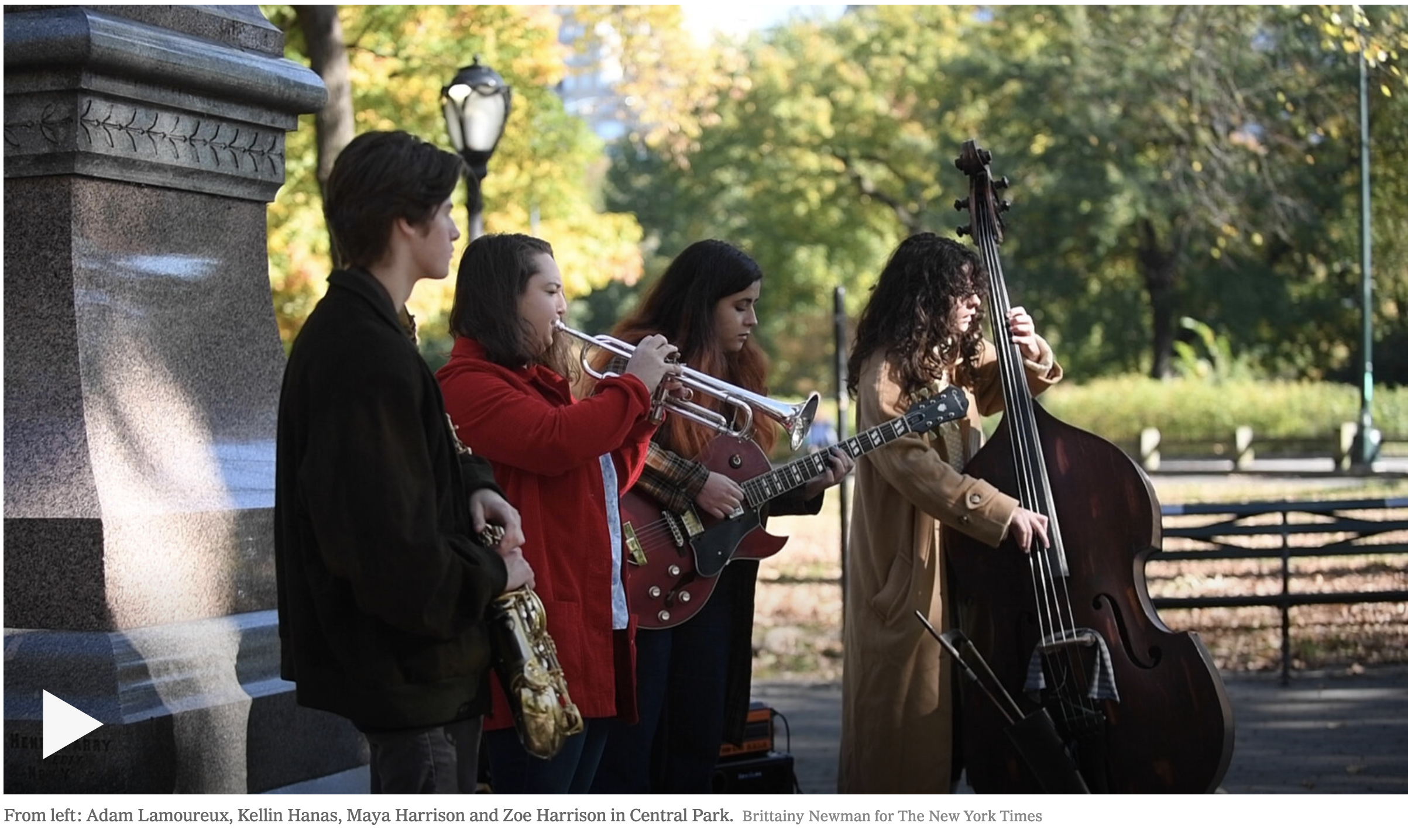The New York Times’ Margot Boyer-Dry writes, “Musicians are playing al fresco all over the city to earn money and boost morale.”
Every night after her shift this spring, Bridget Queral would leave the hospital where she worked as a nurse to find her husband, Luis, waiting to walk her home. As they ambled through an eerily silent Central Park, Ms. Queral would shed the baggage from treating patients during the pandemic’s intense peak. The stroll became a highlight of the couple’s coronavirus routine, even with the lawns devoid of their usual crowds.
When the weather warmed and the virus, for the moment, waned, the sounds of instruments once again rippled through the heavy Manhattan air. “It was really emotional,” Ms. Queral said. “Luis describes it as a black-and-white movie turning to color.”
For many New Yorkers in late spring, hearing musicians performing outside again was a welcome sign of hope and resilience. Throughout the summer and into the fall, jazz tunes, in particular, have become a near-constant presence across the city’s parks, stoops and sidewalks. And that real-life soundtrack can make you feel like you’re walking through a vintage film by Spike Lee or Nora Ephron — not a city in crisis.
It’s easy to get swept up into the New Yorky romance of it all, until you remember that virtually all of the city’s 2,400 indoor performance venues have closed since the coronavirus outbreak, at the same time that concert tours have been canceled, putting countless musicians out of work.
Even so, these makeshift outdoor shows awaken a sense of connection that has been therapeutic for musicians and fans alike.
The communal catharsis reached a new peak on Nov. 7, when crowds descended on Grand Army Plaza in Brooklyn to celebrate the call of the presidential election. Since June, the Prospect Park entrance plaza had served as the regular venue for Wayne Tucker and the Bad Motha’s, who were dutifully playing on that sunny Saturday.
As Mr. Tucker and his fellow musicians played to the champagne-popping throngs, “everyone had so much love for each other,” Mr. Tucker said. “I felt like a messenger delivering that feeling to people.”
The Bad Motha’s are well practiced at delivering relief. Several times each week, they serenade parkgoers with a mix of jazz classics, originals and reinterpreted pop hits in a tight fusion reminiscent of Weather Report.
Keeping in touch with fans over Instagram, the group of 30-somethings has thoroughly charmed the community: One frequent audience member likes to cheer the players on, individually, by name. Another fan, reeling from a breakup, said the band had reawakened her sense of attraction. Even the police, who might in normal times ticket musicians for using amplifiers without a permit, tend to cast a blind eye to any potential violations as they nod along to the beat.
This summer the Bad Motha’s started playing outside to feel the thrill of performing in company after months of playing at home by themselves and found that they could make a bit of cash as well.
Mr. Tucker, who had planned to spend nine months of this year on the road, had flown home from an international tour in March, expecting to leave again soon. As weeks stretched into months and no new gigs appeared, he began to miss performing with others, so he organized a day of busking in the park for his roommates, the keyboard player David Linard, the saxophonist Miles Tucker (Wayne’s brother) and some friends, the bassist Tamir Shmerling and the drummer Diego Joaquin Ramirez.
“We didn’t think we sounded very good,” Mr. Tucker said, but “it got a great response, and we decided to keep doing it.”
Tips for a typical set, gathered through Venmo and an open bass drum case, tend to exceed, ever so slightly, the $100 standard club gig might bring in, Mr. Tucker said. Split among five band members, it’s not much. His group has also been lucky enough to play at socially distanced birthday parties and small weddings, which tend to pay more, but are scarce. In his free time, Mr. Tucker has been helping other musician friends move out of the city that they can no longer afford. He estimates that about half of his performing community is gone.
“It’s something of a sweet and bitter situation,” said Jerome Harris, a bass and guitar player who has toured extensively with jazz greats like the saxophonist Sonny Rollins and the guitarist and composer Bill Frisell. Recently, Mr. Harris has participated in the weekly Prospect Heights Community Jam, which takes place on a stretch of Vanderbilt Avenue in Brooklyn that has been cordoned off for pedestrians and outdoor dining. While connecting with the community has been a joy, he said, that connection arises out of necessity.
In a survey published by the Jazz Journalists Association last month, 61 percent of jazz musicians said their 2020 income would be less than half of last year’s. And 73 percent of American jazz musicians said they had no live performances scheduled for 2021.
Serving as a board member of the Music Workers Alliance, Mr. Harris has been seeking aid and work opportunities for musicians, many of whom are self-employed. So far, the organization’s calls to extend Pandemic Unemployment Assistance have gone unheeded, as have local proposals for safe, outdoor performance opportunities, along the lines of what musicians have been organizing themselves.
Even music schools have limited chances for artists to play together. Kellin Hanas, a freshman trumpeter at Manhattan School of Music, has been organizing busking trips to Central Park to comfort friends from other schools who have grown lonely livestreaming rehearsals from separate practice studios.
Ms. Hanas, an 18-year-old from Wheaton, Ill., can’t quite believe her new venue: “Central Park, holy cow! I saw this on the Disney Channel.” But as her fingers stiffen in the cooling air, she said, Ms. Hanas senses that these idyllic days are numbered.
In Harlem, Berta Alloway is likewise anticipating a wintertime end to the shows she has been hosting on Sunday afternoons in Riverside Park under the memorial to Ralph Ellison, the renowned local (and jazz fan) who wrote “Invisible Man.”
A longtime booker who is known for reinvigorating St. Nick’s Jazz Pub, a Harlem Renaissance landmark, Ms. Alloway has been inviting a rotating cast of players to her outdoor spot around 150th Street.
Patience Higgins, a multi-reed player who has toured with the Duke Ellington and Count Basie Orchestras, among other acts, often headlines with members of the Sugar Hill Quartet. The vocalist Maxine Brown, whose songs “All In My Mind” and “Funny” topped the charts in the 1960s, is also known to appear regularly.
Each week at Riverside Park, older jazz fans arrive early in Access-A-Ride vans to secure spots on benches before neighbors pour out from the surrounding buildings, clapping and swaying along with the players and greeting one another between songs. On one chilly Sunday last month, June Terry, a white-haired regular, was moved to dance to the singer Karl Dixon’s rendition of “Route 66.” The dancing also kept Ms. Terry warm.
Ms. Alloway, known as someone who makes opportunity where there is none, is unsure of what the winter holds. “It’s going to make me sick to my stomach,” she said of the weather forcing an end to her series.
Both Ms. Alloway and Mr. Tucker plan to return to the parks in the spring, particularly if the pandemic continues to block indoor performances. In the meantime, the morale they provide to the public, and the tips they receive in return, will go on pause.
This is not a typical autumn in New York, but that song’s lyrics resonate as deeply as ever: “It’s autumn in New York that brings the promise of new love. Autumn in New York is often mingled with pain. Dreamers with empty hands, they sigh for exotic lands. It’s autumn in New York. It’s good to live it again.”







